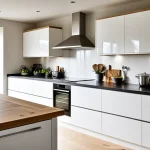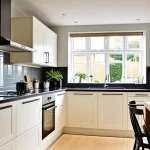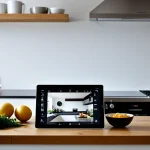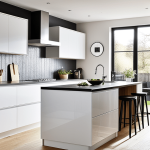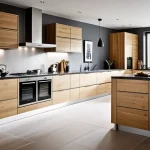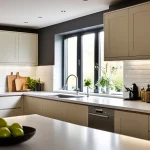Essential Strategies to Visually Expand Your UK Kitchen
When aiming to make a small kitchen look bigger, strategic layout changes are crucial. Opening up the floor plan by removing non-structural walls or choosing an open-plan design enhances spatial flow, giving the illusion of expansiveness. For those without structural flexibility, shifting appliances to create more contiguous workspace or clearer pathways can maximize perceived size.
Incorporating UK kitchen space ideas such as slimline, space-saving appliances is highly effective. Slim refrigerators or narrow dishwashers save valuable floor space without sacrificing functionality. These modern appliances are specifically designed to fit compact kitchens, maintaining utility while reducing clutter.
Also read : How Can I Design a Streamlined UK Kitchen on a Budget?
Maximising the flow of movement is essential in limited kitchens. Clear and direct walkways prevent bottlenecks, making the space feel less cramped. Consider compact islands on wheels or foldable tables that allow flexibility. Arranging functional zones—cooking, preparation, and cleaning—in an efficient sequence optimizes usability and visually expands kitchen dimensions.
These strategies, when combined thoughtfully, offer practical solutions to visually expand kitchen size in UK homes. They emphasize functionality while cleverly manipulating visual perception to overcome real spatial constraints.
Also read : How can color schemes enhance a slim kitchen space in the UK?
Transformative Colour Schemes and Design Elements
Choosing the right kitchen colour schemes can dramatically make a small kitchen look bigger. Light colours for kitchen walls and cabinetry reflect more light, producing an airy, spacious feel. Whites, pale greys, and soft pastels are popular options. Using semi-gloss or satin finishes enhances this effect by subtly bouncing light around the room.
In addition to light colour choices, incorporating reflective kitchen surfaces like glass, polished tiles, or stainless steel appliances plays a key role in visually expanding kitchen space. These reflective materials increase the perception of depth, helping to open up confined areas.
Consistency matters. Employing a unified colour palette throughout the kitchen reduces visual clutter, a crucial component of effective small kitchen design. For example, matching cabinet tones with worktops and walls creates a seamless transition that prevents the eye from stopping abruptly, fostering a continuous flow.
Layering different light shades and finishes adds texture without overwhelming the space, reinforcing a bright, fresh feel. Thoughtfully combining kitchen colour schemes centered on light colours and reflective materials maximises the impact of other space-enhancing strategies found in UK kitchen space ideas. This approach transforms tight quarters into more inviting, expansive environments.
Essential Strategies to Visually Expand Your UK Kitchen
Opening up the layout plays a vital role to make a small kitchen look bigger. Removing non-load-bearing walls or adopting open-plan layouts connects kitchens with adjoining rooms, increasing perceived space. When structural changes aren’t an option, repositioning appliances to enhance flow and clear pathways still helps visually expand kitchen boundaries.
Incorporating UK kitchen space ideas such as slimline, space-saving appliances is fundamental. Choose narrow fridges, compact dishwashers, or under-counter units. These retain essential functions while freeing floor area, directly supporting the goal to make a small kitchen look bigger. Modern designs also maintain style without adding bulk.
Maximising movement flow is crucial. Planning an efficient work triangle between cooking, washing, and preparation zones helps reduce congestion and increases usability. Using mobile islands or foldaway tables adds versatility without consuming permanent space. Altogether, these strategies align with UK kitchen space ideas and practical adjustments that visually expand kitchen interiors, combining aesthetics and function effectively.
Essential Strategies to Visually Expand Your UK Kitchen
To make a small kitchen look bigger, start with clever layout adjustments that open up the floor plan, even when structural changes are limited. Removing or repositioning furniture to create clear sightlines boosts the sense of space. For instance, relocating bulky appliances to less conspicuous areas can visually expand kitchen zones without sacrificing functionality.
Choosing slimline, space-saving appliances is another key UK kitchen space idea. These sleek models, such as narrow fridges or compact dishwashers, are designed to fit snugly while preserving essential performance. Their reduced footprint allows more free area for movement and workspace, which is crucial to visually expand kitchen interiors.
Maximising flow of movement in limited kitchens also enhances perceived size. Arranging work zones to minimise unnecessary steps avoids crowding. Incorporating flexible elements like movable islands or foldaway tables empowers users to adapt the kitchen for cooking and socialising. These practical, user-friendly adjustments directly serve the goal to make small kitchen look bigger, harmonising function and open space in British homes efficiently.
Essential Strategies to Visually Expand Your UK Kitchen
Careful layout adjustments unlock the potential to make small kitchen look bigger by creating a more open floor plan. Removing unnecessary partitions or repositioning appliances to avoid cluttered corners enhances sightlines and spatial flow. Such moves reduce visual barriers and promote a continuous, airy feel.
Selecting slimline, space-saving appliances is vital among effective UK kitchen space ideas. Devices like narrow fridges, compact dishwashers, or under-counter microwave units keep essential functions intact while reclaiming floor area. Their streamlined form also complements modern styling, contributing to a kitchen that feels less crowded.
Maximising flow of movement is equally crucial. Arranging work zones—cooking, preparation, and washing—in a logical sequence minimises unnecessary trips across cramped spaces. Incorporating flexible pieces such as movable islands or foldaway tables allows adaptation for different tasks and social scenarios without permanently occupying space.
Together, these strategies holistically address both functional efficiency and visual spaciousness. They enable British homes to visually expand kitchen interiors, creating environments that feel larger while maintaining usability. Embracing this approach makes the most of limited square footage, a common challenge in UK small kitchen design.
Essential Strategies to Visually Expand Your UK Kitchen
Effective layout adjustments are pivotal to make a small kitchen look bigger. Opening up the floor plan by removing unnecessary partitions or repositioning appliances establishes clear sightlines, which significantly reduces visual congestion. This approach visually expands kitchen space by promoting an uninterrupted flow, essential in compact UK kitchens.
When discussing UK kitchen space ideas, selecting slimline, space-saving appliances plays a key role. Narrow fridges, under-counter dishwashers, and compact microwaves free up floor area while maintaining full functionality. These appliances, designed specifically for smaller spaces, prevent overcrowding, helping to make a small kitchen look bigger without compromising on utility.
Another critical element is maximising the flow of movement within limited kitchens. Organising cooking, preparation, and cleaning zones logically minimises travel distance in tight quarters. Incorporating flexible furniture such as movable islands or foldaway tables further optimises spatial utilisation. Together, these strategies provide a practical framework to visually expand kitchen interiors while enhancing usability.
Adopting these techniques ensures that function and form coexist, embodying effective UK kitchen space ideas that transform confined kitchens into more open, inviting environments.


